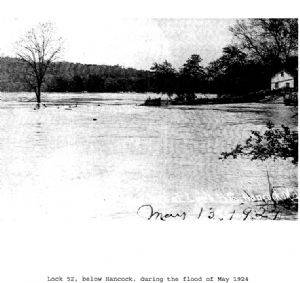Collection Name
About
Chapter 2
THE B&O RAILROAD
A New Philosophy: 1890-1924
Rather than shut down the C&O Canal, however, the B&O Railroad chose to repair it. The prime reason behind the decision was that if the B&O closed the canal, the Washington County Circuit Court would have required its sale to insure that the C&O's bondholders would receive at least a partial repayment. With a sale, a bidding war would have broken out with other railroads interested in acquiring the canal's right-of-way. A competitor running a railway line along the path formerly followed by the canal would have forced the B&O to keep its transportation rates low, reducing revenue. Therefore, the Baltimore and Ohio Railroad decided to rebuild the C&O Canal and operate it as a canal, even if it lost money, rather than closing the waterway and risk losing its right-of-way.
Under the supervision of the court, the B&O could control the canal through a group of trustees, ostensibly to generate revenue to pay off the canal's bondholders, but in reality setting the waterway's toll structure in its own interest and preventing the canal from falling into the hands of an effective competitor.
Under the receivership, the C&O Canal entered a new era. The C&O Canal Company had operated the canal with the goal of it being a reliable, profitable waterway. To that end, the canal company expended vast sums of money to protect the canal from the Potomac River. The B&O Railroad, however, had a different priority --the success of its rail operation. The B&O repaired the canal after the 1889 flood, and kept it functioning for decades afterwards because the alternative was risking a takeover of the canal's right-of-way by a competitor. Hence, the B&O took the measures needed to keep the canal running, but it did not have the incentive of the C&O Canal Company to prevent flood damage. Sustainability was a much less important issue for the B&O receivers than it had been for the C&O Canal Company.
The repair of the canal after the 1889 flood set the tone for the B&O Railroad's tenure over the canal. The B&O initially estimated the cost of fixing the canal at $200,000. When it appeared that the expense might exceed this figure, the railroad lost enthusiasm for the project. Only a threat by the Washington County Circuit Court to sell the canal prompted the B&O finally to start the repairs...
Chapter 3
THE NATIONAL PARK SERVICE
The Canal Revived: 1938-42
By 1938, the Baltimore and Ohio Railroad was in financial trouble, and it sold the C&O Canal to the federal government to repay money borrowed from the Reconstruction Finance Corporation. The federal government was willing to buy the canal because it had long recognized its historic value and recreational potential. Repairing the canal also was viewed as a worthwhile project that could provide employment to workers made jobless during the Great Depression.
In acquiring the C&O Canal, however, federal officials paid little thought to its vulnerability to the Potomac --despite the fact that the most devastating flood ever recorded on the river had occured a scant two years before. Instead, they gave their attention to restoring the canal between Georgetown and Seneca. Congress appropriated $500,000 for the project, which included repairing and rebuilding canal structures, as well as clearing the prism of debris and rewatering it.
The Civilian Conservation Corps (CCC) established two camps to participate in the repairs. The young men in these camps initially cleared trash from around the canal, and then graded the prism and towpath. The Public Works Administration (PWA) oversaw more complex projects such as rebuilding locks, bridges, and repairing large breaks, with actual work done by private contractors, most notably the D.C. construction firm, Corson and Gruman...
